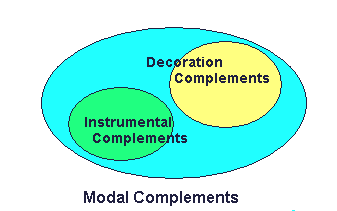|
Language Structures—Part 2: Around the Core / 1 2.1 — COMPLEMENTS Let us call complement anything which is found in a clause in addition to its core (i.e. beside its subject, predicate and - when requested - object).
With the new company Mary earns a good salary. The removal of with the new company doesn't make the clause collapse. "Mary earns a good salary", being the core, ensures that the statement stays intelligible. The segment with the new company adds more information to what the core says but can be done without: it is a complement. Let us now group complements into categories which, although arbitrary, clarify their role.
Examples of "place complements" are:
Time complements are of the kind: last night, within 5 minutes, over the last century, immediately, soon, yesterday etc.
2.1c — Instrumental complements Examples:
2.1d — Decoration complements If the label "instrumental" seems far-fetched for with red flowers in a clause like The wedding room had been embellished with red flowers, one may want to think of a category labelled decoration complements.
2.1e — Modal complements (also: of manner) Or we may want to conceive a larger category which lumps together both the "instrumental" and "decoration" categories. Let us call it modal complements.

But modals do trigger subject/predicate inversion: Under no circumstances should you believe this. Modal complement "under no circumstances" moves the subject "you" behind "should" - an element of the predicate "should believe". This is called "subject-verb inversion". (For more, read an article on this.) 2.1f — Relational complements An example is "I went to the movies with some friends", where "with some friends" could be labelled accompaniment or togetherness complement, or relational complement. Other relational examples are:
2.1g — Complements of belonging, ownership They clarify whereto something belongs as a sub-part, because it is owned or as a result of functional links. Examples:
The 's form (as in "Company's") is known as Saxon Genitive(1). In English, the "s" is dropped after a noun ending in –s. So, we write: The parents' house …, Francis' car … . The Saxon Genitive may just string two words together to signify dependence, mutual relationship: house key (the key fitting the lock of a particular house). The two words may merge altogether (landlord) or be joined by a hyphen (week-end).
2.1h — Causal complements They state the reason why something takes place:
2.1i — Destination (Target) complements They identify the recipient of something being transferred or addressed. Examples:
The "me" of the last example is evidently not an object (the object of showing is the passport) but a destination complement - as confirmed by the possible rewording into Please, show your passport to me. In a clause like "Do introduce me to your friend", "me" would be the object and "to your friend" the destination complement.
The direct object of transitive verb "gave" is "a watch". Placing indirect and direct objects side by side ("him", "watch") is known as "direct construction" or "double accusative construction".
An example of this follows: Der Lehrer hat mich die starken Verben abgefragt. It means: Both mich (the destination complement) and die starken Verben (the object) are set in accusative case. The regular German construction for the destination complement (equivalent to the English to me construction) is mir (dative case) instead of mich. Note that, in the double accusative construction, the complement precedes the object. Like Complements of Belonging, also Destination Complements can be seen as a sub-group of the Relational Complements. 2.1j — Purpose complements Examples of Purpose complements(2) are:
The riddle shall be clarified in Part 4, where complex language is discussed. There we shall realise that clauses are arranged in a hierarchy based on a main clause and branching out into a network of complementary (subordinate) clauses. The long and short of it is that language hinges on cores linked to more or less optional complements. So far we have mainly reviewed the complements found in a single clause. In the closing section of this document the notion of complement shall expand to include subordinate clauses within a complex sentence. The first four examples of purpose complements allow a glimpse of such constructions. The sections in between analyse more in depth the elements found in a self-standing clause, namely particles, nouns and their ancillary elements (articles, determiners, adjectives), verbs and their ancillary elements (adverbs).
FOOTNOTES
(1) – The Saxons are a sub-group of the Germans. Other Germanic languages are: English, Dutch, Icelandic, Norwegian, Swedish, Danish.
|